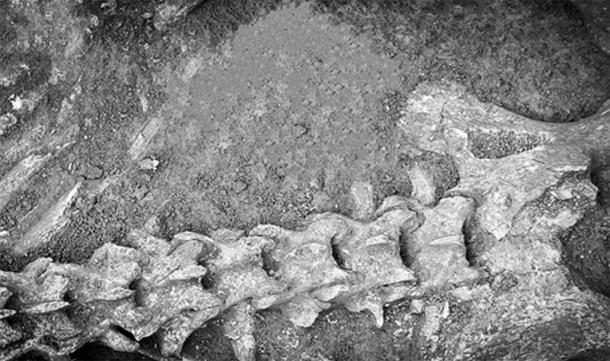Giant Panda Skeleton Found in Ancient Royal Tomb in China
The skeletal remains of a giant panda have been unearthed from a royal tomb in China dating back approximately 2,000 years to the Western Han Dynasty . This find, not only sheds light on the prominence of these revered creatures in ancient Chinese culture but also offers a tantalizing glimpse into the environmental conditions of an era long past
ECNS.cn reported that archaeologists, in late 2021, chanced upon the full animal skeleton during their research at the grand burial site of Emperor Wen of Han near Xi’an, Shaanxi Province. This skeleton was later identified as a giant panda’s.
Emperor Wen , 202 – 157 BC, was renowned for his empire’s reformative approaches, his austere lifestyle, and his empathy for the populace. Contrary to many of his contemporaries, he chose to have his burial site within a mountain, avoiding a traditional burial mound.

The panda’s skeleton was found in Emperor Wen’s tomb. Photo from the Chinese Institute of Archaeology
Details on the Giant Panda Discovery
The panda’s skeletal remains showed prominent canine teeth and were meticulously positioned within a brick formation pointing towards the emperor’s resting place, with its tail directed west. On comparing this with current giant panda skeletons, experts from the Shaanxi Academy of Archaeology ascertained its species.
Researcher Hu Songmei from the Shaanxi Academy of Archaeology shared with cover.cn that the unearthed remains seem to correspond with the larger Qinling subspecies of pandas.
The Qinling pandas, a unique subspecies of the giant panda, are native to the Qinling Mountains , which act as a natural boundary between China’s north and south. Historically, this subspecies has been geographically isolated due to the mountainous terrain, leading to distinct morphological and genetic differences from their more widely recognized counterparts, the Sichuan giant pandas. One of the most distinguishing characteristics of the Qinling panda is its brown and white pelage, in contrast to the typical black and white fur of the Sichuan variety. Additionally, they tend to have a rounder skull and smaller molars. Their geographical isolation also means they have adapted to a specific habitat and ecological environment unique to the Qinling Mountains.
Hu Songmei pointed out that studying the bones of the remains found in the tomb offered a peek into the climatic conditions of that period, theorizing that this particular panda possibly hailed from the forests on the Qinling Mountains’ northern side, which might have been warmer and more moisture-rich back then.
Interestingly, in 1975, a similar discovery was made near the tomb of Empress Bo, Emperor Wen’s mother
Pandas in Chinese Culture
Throughout Chinese history, Giant Pandas have been esteemed as “forest’s revered beings” and “living relics”, surviving since the Pleistocene epoch, a time when saber-toothed tigers roamed. Their symbolic significance in Chinese society has been longstanding, representing tranquillity and peace. Historically, they were treasured by rulers, often employed as prized offerings to other royals and foreign dignitaries. Ancient warriors often drew parallels with these creatures for their might and courage.
According to earthstoriez, during the West Jin Dynasty, the Giant Panda was termed Zhouyu. Its herbivorous diet and non-aggressive nature earned it the title of the “justice animal”, symbolizing amicability and peace. Legend has it that warring factions would halt confrontations when a flag bearing the Zhouyu was raised.
A Royal Garden Feature?
The royal tomb with the panda skeleton also housed the remains of other rare creatures like tigers, tapirs, buffalos, oryx, serows, and yaks, suggesting the Han Dynasty’s belief in an afterlife reminiscent of their earthly existence. Wu Xianzhu from the Hubei Provincial Archaeology Research Institute remarked on the significance of pandas in burials, emphasizing the ancient connection between humans and these creatures.
Researcher Cao Long from the Shaanxi Academy of Archaeology postulated that given the diversity of animals found and the number of pits, it seems more like a royal garden feature than a personal preference for pandas.
Qinling Giant Pandas in China Today
Urbanization, deforestation, and infrastructure development have contributed to habitat fragmentation and loss, leading to increased human-panda conflicts and a reduction in their natural food sources, primarily bamboo. As of recent estimates, there are only around 300-400 Qinling pandas in the wild, making them a vulnerable and essential focus of conservation efforts. To address these concerns, the Chinese government and various conservation organizations have been working to establish protected areas and implement conservation strategies specifically tailored to the Qinling panda’s unique habitat and needs. These measures aim to ensure the subspecies’ survival and the preservation of its distinct genetic lineage.
Related Post
A shocking documentary proves that mermaids do exist
SHOCKING Revelation: Thuya, Mother of Queen Tiye, Was the Grandmother of Akhenaten and Tutankhamun—What Ancient Egyptian Secrets Did She Leave Behind?
Breaking News: Astonishing Discoveries at Karahan Tepe Confirm an Extraterrestrial Civilization is Hiding on Earth, and NO ONE Knows!
Breaking News: Researchers FINALLY Discover U.S. Navy Flight 19 After 75 Years Lost in the Bermuda Triangle!
NASA’s Secret Investigation: Uncovering the Astonishing Mystery of the UFO Crash on the Mountain!
Explosive UFO Docs LEAKED: Startling Proof That Aliens Ruled Ancient Egypt!